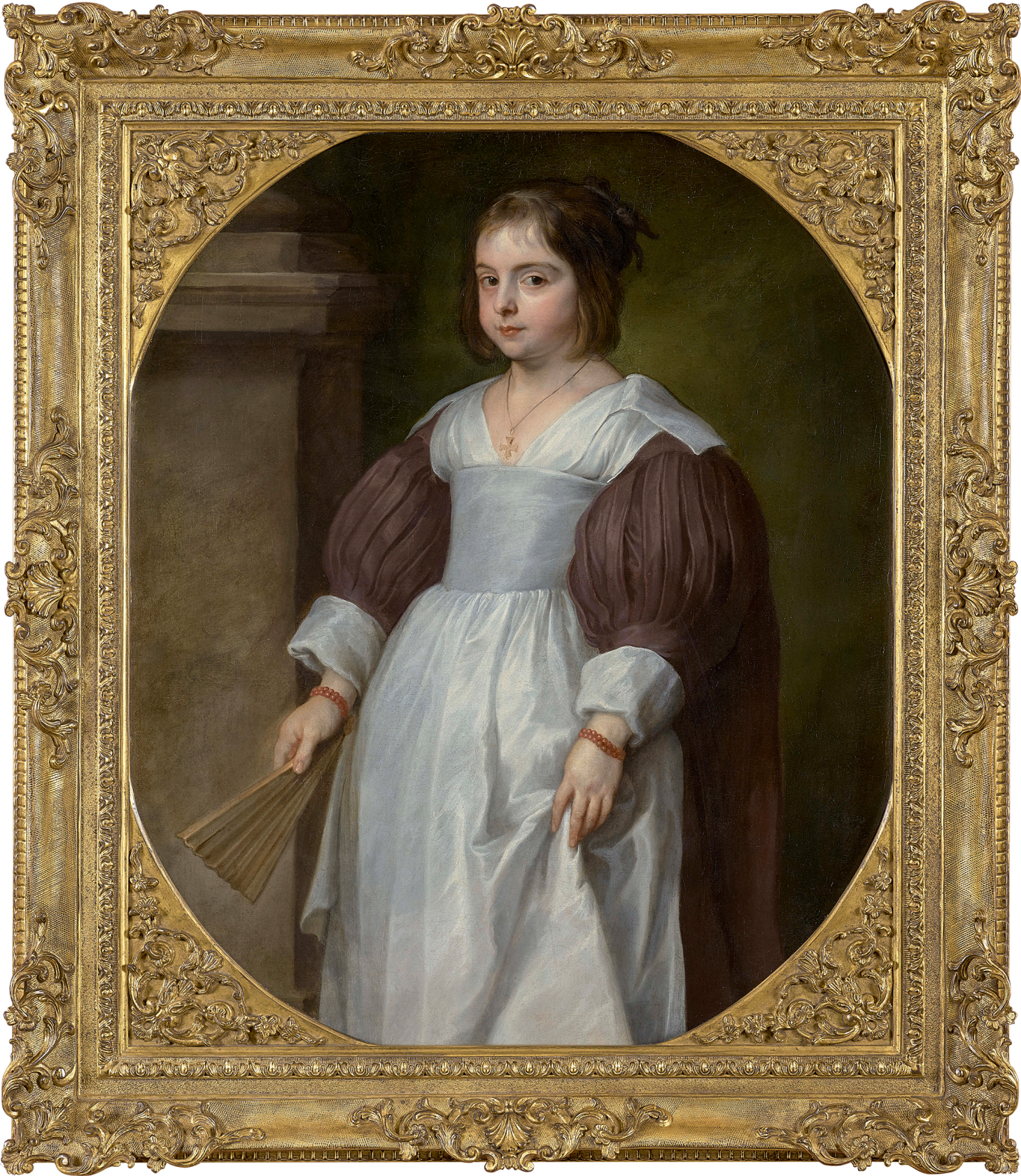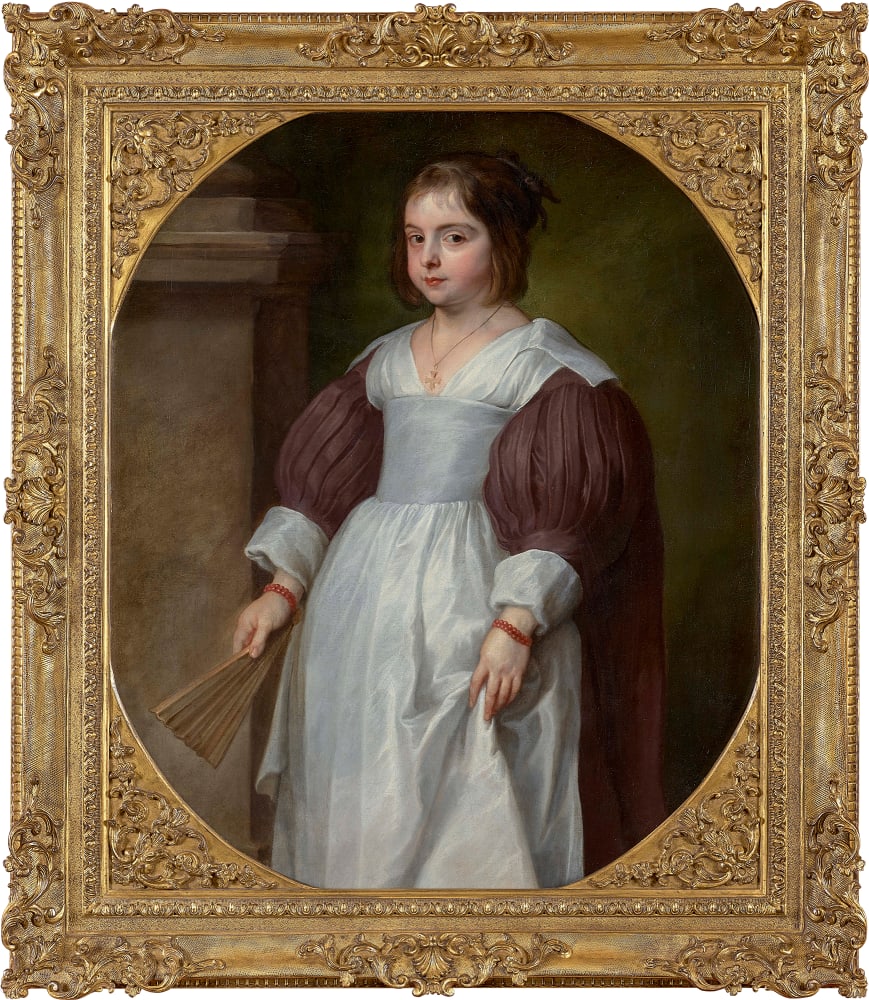


Anthony Van Dyck
(1599-1641) Portrait of a Young Girl in a White ApronProvenance
Emmerich Joseph, Duc Dalberg (1773-1833), by whom sold;
Claude Louis Chariot auctioneers, Paris, 21st March 1820, lot 98, as: ‘Van Dich (Antoine)’ / ‘Portrait d'une jeune fille vêtue d'une robe de couleur et d'un tablier blanc qu'elle tient d'une main et de l'autre un éventail. Ce morceau est de la plus grande vérité, et sa belle exécution le rend digne de la réputation de son auteur ; la tête de la jeune fille est d'un pinceau suave et d'un coloris frais et séduisant’.
Charles Maurice de Talleyrand-Périgord (Prince Talleyrand) (1754-1838);
John Smith (1781-1855) (art dealer);
Lord Charles Townshend (1785-1853);
Christie’s, London, 11 April 1835, lot 43;
Christianus Johannes Nieuwenhuys (1799-1883) (art dealer);
Rotchschild Collection, Paris by 1860, by whom sold;
Christie’s, Paris, ‘Le Haras d’Estimauville; Oeuvres et Objets d’Art provenant des Collections Rothschild.’, 27 October 2010, lot 364, as ‘Ecole Flamande du XVIIéme Siécle, Portrait d’une Jeune fille tenant un éventail. Probablement ovale à l’origine’.
Philip Mould & Co.;
Private collection, UK.
Literature
Avery-Quash, S. (ed.) ‘The Travel Notebooks of Sir Charles Eastlake’, The Walpole Society, Vol. 73, 2011, 2 Vols., Vol. I, p.525.
Sebag-Montefiore, C & Armstrong-Totten, J. (2012) A Dynasty of Dealers: John Smith and Successors 1801-1924, London: The Roxburghe Club, p.130, 146.
Exhibitions
The Ashmolean Museum, Oxford, 2012-2017
Publications
We are grateful to Prof. Christopher Brown and Dr. Susan Barnes for confirming the attribution to Van Dyck on first-hand inspection.
With its compositional details and nuanced facial expression, this tenderly portrayed Flemish child is a masterful example of Van Dyck’s capacity to combine social protocol with the affecting subtleties of childhood.
The sitter’s identity has not been established, but her relatively unostentatious clothes seem to suggest that she is a non-aristocratic or royal subject, making it untypical in Van Dyck’s portraiture of children in the period following his return from Italy in 1627, after which date the majority of his child sitters came from ruling dynasties. Furthermore, the sitter is shown by herself and not with other children or a supporting adult, which is true of many of the other child portraits by Van Dyck. The result is a work of startling presence and freshness.
We see exactly this in the present portrait. Standing with her body turned...
We are grateful to Prof. Christopher Brown and Dr. Susan Barnes for confirming the attribution to Van Dyck on first-hand inspection.
With its compositional details and nuanced facial expression, this tenderly portrayed Flemish child is a masterful example of Van Dyck’s capacity to combine social protocol with the affecting subtleties of childhood.
The sitter’s identity has not been established, but her relatively unostentatious clothes seem to suggest that she is a non-aristocratic or royal subject, making it untypical in Van Dyck’s portraiture of children in the period following his return from Italy in 1627, after which date the majority of his child sitters came from ruling dynasties. Furthermore, the sitter is shown by herself and not with other children or a supporting adult, which is true of many of the other child portraits by Van Dyck. The result is a work of startling presence and freshness.
We see exactly this in the present portrait. Standing with her body turned slightly towards us, she holds us with a sideways glance. In a touching gesture, perhaps one of nervousness, she clutches at her apron which can be taken as signature attire for a youngster. The fan that she holds in her right hand looks oversized and, like the column pedestal next to which she stands, reminds us that the scale is very much that of a child. But unlike many of his portraits of adult sitters, in which he often used a separate model for the hands, Van Dyck has here realised sitter’s hands with exquisite individualism, with the diminutive proportions and chubby fingers revealing them to be very much those of a child. The red coral strings bedecking her wrists, a frequent adornment of young children of the period, and considered a protection against medical and unseen evils, further testify to her minority.
The tensions and allusions to the junction between childhood and adulthood expressed in her pose, setting, and iconography, are played out to the full in her facial expression. This is where Van Dyck displays his ineffable sophistication in expressing the subtleties of individuality within the strictures of contemporary refinement and protocol. In what can be seen as a dress rehearsal for his epoque-defining portraits of the young children of Charles I in the following decade (the most significant of which being recently exhibited at Compton Verney), Van Dyck has represented his subject as expressing contrasting generational viewpoints. Although this little girl, perhaps no more than ten years old, is conforming to the decorum of a formal sitting, there is also assertion in her gaze. In the childishness of her rounded features and keen young eyes, a beguiling child emerges from beneath the straitjacket of adult roleplay.
Van Dyck’s second Antwerp period marked a turning point in his career. His years in Italy had helped only to cement the reputation that he had earned as Peter Paul Rubens’s (1577-1640) favourite and his best student. In 1628, following his return and perhaps conscious of the death of his sister the year before, he made a will, a gesture that reflects his graduation from student to master in his own right. Over the following four years, the artist brought his recent experiences in Italy to bear on the art of his native city. Benefiting from Rubens’s absence from Antwerp on business at the courts of Madrid and London, Van Dyck was able to establish a flourishing practice of his own in Antwerp, whose only rival was that of another talented product of Rubens’s studio, Jacob Jordaens (c.1593-1678). Late in 1628, in a mark of his new stature, he was awarded a valuable gold chain by the Archduchess Isabella Clara Eugenia (1566-1633) in thanks for painting her portrait. In July 1631, perhaps hoping to seek new opportunities following the return of Rubens, he travelled to the Hague, where he proceeded to transform the portraiture of the court of the House of Orange. The experience was a reassuring one for Van Dyck as it showed that it was possible for him, a Catholic artist, to work successfully and comfortably in a Protestant country. The result of this was that in 1632 he travelled to London to work for the court of Charles I (1600-1649). Within a year, Van Dyck – who had been known to the court since his first visit in 1620-1 – had been made ‘principalle Paynter in Ordinary to their Majesties’, leapfrogging the capable but less talented artist Daniel Mytens (c.1590-1647), who had been working as the principal court portraitist for the past seven years. By 1634, Mytens, forced to work at times from Van Dyck’s models, had decided to return home.
So who could this sitter be? Sadly, few clues could be found in the provenance, which could only be traced back to the nineteenth century. The prominently displayed cross worn by the sitter tells us only that she was likely a Catholic.
Nevertheless, the provenance of the portrait suggests that it has always been a highly coveted work, at times even dangerously so. One of its first recorded owners was no less a figure than Prince Talleyrand (1754-1838), the minister who famously managed to serve from the reign of Kings Louis XVI (1754-1793) to Louis-Philippe of France (1773-1750), whilst maintaining his position during the years of the Revolution and the Napoleonic Empire. During the Second World War, it was looted from a cadet branch of the Rothschilds – whose family had been its rightful owners for much of the past century – by the Nazis, before being rightfully resituated in 1946. It remained in the possession of the family until it was sold at auction in 2010 as a work by an unknown Flemish artist. Following its acquisition by this gallery, multiple layers of discoloured varnish and overpaint which previously masked its qualities were removed, and it is now accepted as an autograph and notably high-quality work by Van Dyck.



